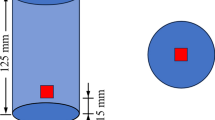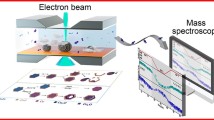Abstract
Alumina-aluminum composites can be prepared by reactive metal penetration (RMP) of mullite by aluminum. The process is driven by a strong negative free energy for the reaction (8 +x)Al + 3Al6Si2013 → 13Al2O3 + 6Si + xAl. Thermodynamic calculations reveal that titanium oxide, aluminum titanate, nickel oxide, and nickel aluminate all have a negative free energy of reaction with aluminum from 298 to 1800 K, indicating that it may be possible to form alumina-intermetallic composites by reactions of the type (2 +x)Al + (3/y) MOy → Al2O3 + AlxM3/y. Experiments revealed that aluminum reacts with titanium oxide, nickel oxide, and nickel aluminate, but not aluminum titanate, at 1673 K. Reaction with the stoichiometric amount of aluminum (x = 0) leads to the formation of alumina and either titanium or nickel. In some cases, reactions with excess aluminum (x > 0) produce intermetallic compounds such as TiAl3 and NiAl.
Similar content being viewed by others
References
R.E. Loehman, K.G. Ewsuk, and A.P. Tomsia:J. Am. Ceram. Soc., 1996, vol. 79 (1), pp. 27–32.
E. Saiz, A.P. Tomsia, R.E. Loehman, and K.G. Ewsuk:J. Eur. Cer. Soc., 1996, vol. 16, pp. 275–280.
Y. Gao, J. Jia, R.E. Loehman, and K.G. Ewsuk:J. Mater. Res., 1995, vol. 10 (5), pp. 1216–1225.
W.G. Fahrenholtz, K.G. Ewsuk, R.E. Loehman, and A.P. Tomsia: inIn-Situ Reactions for Synthesis of Composites, Ceramics, and Intermetallics, E.V. Barrera, S.G. Fishman, F.D.S. Marquis, N.N. Thadhani, W.E. Frazier, and Z.A. Munir, eds., TMS, Warrendale, PA, 1995, pp. 99–109.
M.C. Breslin, J. Ringnalda, J. Seeger, A.L. Marasco, G.S. Daehn, and H.L. Fraser:Ceram. Eng. Sci. Proc, 1994, vol. 15 (4), pp. 104–12.
T. Cheng:J. Mater. Sci. Lett., 1993, vol. 12, pp. 376–78.
R.A. Robie and D.R. Waldbaum: Geological Survey Bulletin 1259, United States Department of the Interior, United States Government Printing Office, Washington, DC, 1968.
M.W. Chase, Jr., C.A. Davies, J.R. Downey, Jr., D.J. Fruip, R.A. McDonald, and A.N. Syverud:JANAF Thermochemical Tables, 3rd ed.,J. Phys. Chem. Ref. Data, 1985, vol. 14 (1), pp. 1–1856.
Thermochemical Properties of Inorganic Substances, 2nd ed., O. Knacke, O. Kubaschewski, and K. Hesselmann, eds., Springer-Verlag, Berlin, 1991.
T.B. Massalski:Binary Alloy Phase Diagrams, 2nd ed., ASM INTERNATIONAL, Materials Park, OH, 1992.
Author information
Authors and Affiliations
Additional information
This article is based on a presentation made in the “In Situ Reactions for Synthesis of Composites, Ceramics, and Intermetallics” symposium, held February 12–16, 1995, at the TMS Annual Meeting in Las Vegas, Nevada, under the auspices of SMD and ASM-MSD (the ASM/TMS Composites and TMS Powder Materials Committees).
Rights and permissions
About this article
Cite this article
Fahrenholtz, W.G., Ewsuk, K.G., Loehman, R.E. et al. Formation of structural intermetallics by reactive metal penetration of Ti and Ni oxides and aluminates. Metall Mater Trans A 27, 2100–2104 (1996). https://doi.org/10.1007/BF02651864
Issue Date:
DOI: https://doi.org/10.1007/BF02651864




